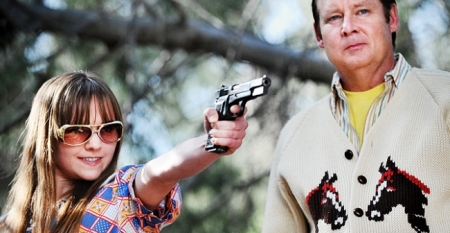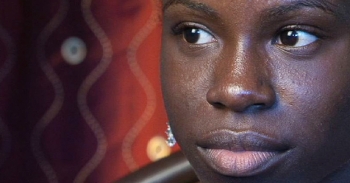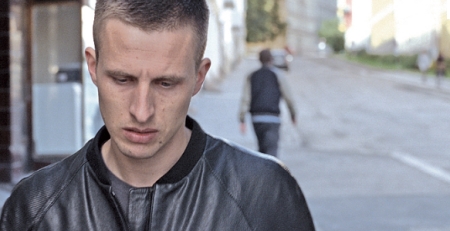Film Essent Archive for September, 2011
Shana Tova
Today at sundown marks the start of Rosh Hashanah, the Jewish New Year. Rosh Hashanah is the the beginning of a time of reflection in the Jewish faith called aseret yamei teshuva, or ten days of penintence; Rosh Hashanah is not just about asking forgiveness from God for the things we’ve done wrong in the past year, but about seeking out and apologizing directly to those we’ve harmed. It’s the time of year to reflect upon how we’ve been doing with regard to repentance (teshuva), prayer (tefillah) and charity (tzedakah).
But what do those things really mean, as we apply them to our lives? The idea of repentance isn’t just about apologizing and being forgiven, it’s about strengthening community, about trying to live a life of righteousness. It’s about how you make your life have meaning outside of yourself, every single day, about the kind of person you strive to be — not just on Rosh Hashanah, but every day of the year. And you don’t have to be Jewish to find value in the spirit of what Rosh Hashanah means.
Read the full article »
Point of View: Activist Barbara Brenner on Pink Ribbons and Pinkwashing

 I found Pink Ribbons, Inc, which I reviewed at Toronto, so fascinating that I had to follow-up on it. My grandmother died of breast cancer that we thought was cured, but that suddenly came back aggressively a couple decades after we thought she was done with it, metastasizing into her lung and ending her life very rapidly. We have a family history of breast cancer, so as a person with those particular lady parts, and three daughters who will also carry that genetic risk of potential breast cancer down the road, this is a topic that’s pertinent to me. And my own experience with being very ill in late 2009-early 2010 drove home for me even more the need to think about causes and prevention and what I can do to ensure my own continued good health for a long time.
I found Pink Ribbons, Inc, which I reviewed at Toronto, so fascinating that I had to follow-up on it. My grandmother died of breast cancer that we thought was cured, but that suddenly came back aggressively a couple decades after we thought she was done with it, metastasizing into her lung and ending her life very rapidly. We have a family history of breast cancer, so as a person with those particular lady parts, and three daughters who will also carry that genetic risk of potential breast cancer down the road, this is a topic that’s pertinent to me. And my own experience with being very ill in late 2009-early 2010 drove home for me even more the need to think about causes and prevention and what I can do to ensure my own continued good health for a long time.
So I followed up with one of the activists featured prominently in the film, Barbara Brenner, former Executive Director of the activist group Breast Cancer Action, who now blogs regularly on her own site, Healthy Barbs. Barbara was diagnosed with Breast Cancer in 1993, helmed BCA for 15 years, and currently writes a lot about things like research, environmental causes related to cancer, and her own struggles now in dealing with ALS. Her recent post on what she’s gone through by agreeing to participate in a clinical trial for a new drug for ALS treatment is particularly harrowing.
Barbara very kindly pointed me to a lot of information about her work with Breast Cancer Action and agreed to an email interview to provide some clarification about why she feels so strongly that “pinkwashing” the issue of breast cancer is detrimental.
Read the full article »
Calling Bullsh*t on Willful Ignorance and Stupidity

This morning, the very intelligent Matt Zoller Seitz got my blood pressure up a notch by posting to Facebook this recent GQ column by Natasha Vargas-Cooper titled “Canon Fodder: Terminator 2: Judgement Day.” This piece angered me, not because it’s thoughtful or well-written or smart or greatly contributes to a discussion of film generally, but because the author’s specious argument is so mind-bogglingly off-base, so astoundingly, willfully ignorant, that it cannot be allowed to pass as what we call “writing about film” without a challenge.
Let’s start with the very title of this presumably ongoing column series, “Canon Fodder.” Perhaps GQ and Ms. Vargas-Cooper weren’t intentionally name-stealing from the very popular Onion AV Club series, New Cult Canon. Let’s be kind and just assume that, since the rest of her piece implies that everything that she needs to know to write about film can start with all things post-Tarantino, the author perhaps also isn’t terribly well-versed in the rest of that great big place called The Internet (much less anything printed on that ancient medium, paper) wherein a lot of very smart people are writing now, and have written in what we like to call “the past,” much smarter pieces that this about film. Ignorance is no excuse, though; Vargas-Cooper and her GQ editors should perhaps go peruse the much more intelligently written and thoughtful pieces in New Cult Canon, and then seriously reconsider both the name of this column and the need for it to exist at all.
Now, back to this piece of ridiculous fluff, which masquerades as “writing” much like a toddler likes to totter around it its mother’s stiletto heels and makeup, pretending to be a real grown-up. Vargas-Cooper opens her piece with this gem of wisdom:
As an experiment, let’s exist in a universe where our generation of filmmakers is enough to fill out the movie canon. Let the film school prigs, art house snobs, and the better half of film critics publishing today slavishly catalogue the classics and engage in numbing debates over who did it first and who did it better. Whether reverence for movies from a bygone era is rooted in merit, nostalgia, or neurosis about film being an inferior medium to literature, movies keep pace with social mores of a time and deserve to be free of the tastes and prejudices of people who grew up without Quentin Tarantino.
First off, the assumption that all younger writers are unwilling or unable to appreciate the way in which the history of filmmaking informs the present is simply false. That may be the case for Ms. Vargas-Cooper, but I do happen to know quite a few 20-something filmmakers and film journalists who would beg to differ that it applies to them. If you are one of that set of smart, thinking younger filmmakers and journalists, well, you know who you are, and the forthcoming smack-down does not apply to you. But if you are a younger writer and you read Vargas-Cooper’s piece and thought “Yeah, right on!” or “Hell no! We don’t need us no edumacation about movies. Good movie makes big loud boom!” then yes, I am talking about you too, kiddo.
So. As an experiment, let’s pretend that those among us who “slavishly catalog” the classics and engage in what, to many of us, constitutes more “intelligent discourse” than “numbing debate,” do so for reasons that perhaps the author hasn’t bothered to consider while wallowing in the unbridled youthful arrogance and lazy thinking of this collection of words we’ll loosely refer to, for the sake of argument, as “writing.”
I mean, I get that when you’re learning to write about film you don’t know everything. Hell, even when you have been writing about film for as long as I and some of my oldster friends have, you still don’t know everything. Far from it. I’ve been studying film intently for well over a decade now, and the gaps in my own knowledge even after all those years of work and rigorous study humble me. If you want to write intelligently about a field as complex as film, you are always and forever learning new things, honing your understanding of how this film influenced that one, learning from the path that all those who have gone before you have forged. You need to seek to expand the universe of your mind beyond the little kid grilled-cheese-and-mashed-potato-diet that you subsisted on in your youth, and be willing to experiment with the foods the grown-ups eat. So you try sampling the sushi and the kim-chee and the steak tartare, all the incredible variety of foods on the cinematic buffet, to expand your experience and hone your own taste in film by gaining an appreciation for all the things that aren’t already familiar to you.
It’s by learning, and study, and discourse with people who know more than you do, and thinking really hard about why a film works or why it does not, that you learn to expand your intellectual cinematic palette. You don’t go into writing about film thinking that everything you need to know about it can be learned by studying only the films your generation grew up on. Sorry, but it’s just not that easy. The ease of typing words on a keyboard and publishing them on the Internet has had the unfortunate effect of making an awful lot of people who are not, in fact, good or even fair-to-middling writers, think that they are, but the ability to string some words together using basic sentence structure does not mean you are yet a writer capable of writing intelligently or thoughtfully about film, anymore than the ability to aim a video camera and push a button makes one a filmmaker whose output is worth watching.
Moreover, for someone who presumably wants to write about movies as a career goal to assert, essentially, that the 120 year or so history of filmmaking is somehow irrelevant to the present of our field is mind-bogglingly dense. And I don’t mean “dense” in the sense that Ingmar Bergman’s films are dense — but then perhaps the author isn’t actually aware of his work, him being one of those old-school filmmakers whose work she doesn’t want to consider as having any relevance to film in the present. What I mean here is “dense” as in “stupid and thick-headed.” Just so we’re on the same page.
I mean, criminy. I don’t think you need a degree in film studies to write about film, but in the absence of that you sure as hell need to have a passion for film (which includes those boring classics that sometimes make your brain work a little hard) and more importantly, a willingness to know where the gaps in your knowledge are and to do your best to fill them through a rigorous course of self-study. If you’re not willing to do that, to apply a little thought and critical thinking to your work, then for pity’s sake, go find another line of work that is better suited to a willingness to remain so blissfully ignorant of the history of your field. The desire to embrace ignorance, to say, in essence, that it’s just too hard to study and learn the foundation of your field, does not qualify one in any way to be writing about it from the perspective of “ignorance is bliss.” What cheek.
Working in any intellectual field — architecture, science, mathematics, history, religion, philosophy, literature, and, yes, film — requires an understanding of the history of that field, because that history is the very foundation on which everything that is current in that field was built. Reverence for movies from a “bygone area” has nothing to do with baseless nostalgia, young whippersnappers. It is about understanding how filmmaking came to evolve to where it is today. It’s not about any neurosis about film being inferior to literature, it is about understanding that film is an art form that has been largely hijacked as a medium for mind-numbing entertainment, and about appreciating those filmmakers — and those fuddy-duddy critics and scholars — who are striving every single day to keep the watermark for film as art high. It’s about not allowing an art form that we feel passionately about to be reduced to little more than bullshit reality television for the masses on a big screen.
Art can also be (and often is) entertaining, but the assumption that modern social mores should circumvent an innate understanding of the foundation of cinematic history, that working out of ignorance and banality has any merit whatsover, is just ludicrous. Or to put it in simpler terms to make it easier to digest: Bullshit.
18 Comments »TIFF ’11 Reviews: Last Roundup — Your Sister’s Sister, Chicken with Plums, Pink Ribbons, Inc. and Lucky

Your Sister’s Sister
With her latest film, Your Sister’s Sister, writer-director Lynn Shelton again teams up with Mark Duplass, who plays Jack, an affable slacker caught between two sisters, Iris (Emily Blunt) and Hannah (Rosemarie DeWitt) in this lightly drawn but well-executed tale. Shelton has a knack for putting average people into beyond-average situations, as she did with Duplass and Josh Leonard in her last film, Humpday, which had the hook of two long-time best friends who get caught up in a drunken bet to have guy-on-guy sex on film for the sake of making a porno to enter in The Stranger’s annual Humpday competition.
This time around, Shelton’s hook is that Jack is in love with Iris, whose ex-boyfriend was Jack’s now-deceased brother. Jack’s having trouble coping with the loss of his brother and needs some mental space, so Iris offers him — or rather insists that the accept — the use of her parents’ island getaway house. When he gets there, he finds the house already occupied by Iris’s lesbian half-sister, Hannah, who’s come to the house to nurse her own wounds over the recent breakup of a long-term relationship. And confusion, awkwardness and occasional hilarity ensue.
Shelton handles her triad of characters with a sure hand, smoothly guiding them, and us through Jack’s relationships with both Iris and Hannah, and theirs with each other, as they navigate the rocky road of where this island getaway vacation takes them. As with Humpday, Shelton’s made a film that’s warm, heartfelt and accessible, with characters who feel like the kind of people you might actually have in your own life.
Read the full article »
TIFF ’11 Reviews: Oslo, August 31 and Melancholia

Oslo, August 31
One of the last films I caught at TIFF this year, almost by accident, was Oslo, August 31, the sophomore effort of Reprise director Joachim Trier. Oslo, August 31 reunites Trier with Anders Danielsen Lie (who played Phillip, the troubled writer of Reprise) in this spare film about addiction, the choices that define a life, and what happens when you’ve screwed it all up so badly that you can’t see a way back out through starting over.
The film opens with a spate of “I remember ….” voice-over memories of growing up in Oslo from a chorus of unseen voices, then unceremoniously introduces us to Anders (Anders Danielsen Lie), a 34-year-old recovering addict, once a promising writer, now a recovering, suicidal addict who’s about to get out of rehab.
Shooting in Oslo, and setting the film as summer transitions into fall, Trier uses camera angles and shadows to give Anders’ return to Oslo a closed off, foreboding vibe that plays well with the sense that the recovering addict feels already that all the doors are shut, his path already chosen. It’s clear that Anders doesn’t believe in himself, so it’s hard for us to believe in him. Trier chooses not so much to foreshadow the ending of the film with its beginning, as to deliberately telegraph it, an effective dramatic device that forces the audience to feel Anders’ sense of despair, isolation and hopelessness.
Read the full article »
TIFF ’11 Review: Alps

One of my strongest festival memories is of watching Giorgos Lanthimos’ third film, Dogtooth, at TIFF in 2009, and walking out of the theater with a mass of fellow dazed critics, filled with excitement at having just seen this bizarrely brilliant work by an artist who seemed to materialize out of nowhere with the rare potential to be a cinematic game-changer. We weren’t quite sure what the hell we’d just seen, but we knew it was something unique and crazy, a work by a filmmaker with a distinctly unique perspective and vision. It was the kind of film you hope to discover at a film festival, the tiny gem you discover and appreciate only after sifting through countless grains of sand. Two years later, I still can’t get it out of my head.
Read the full article »
TIFF ’11 Review: Goodbye First Love


With her latest film, Goodbye First Love, Mia Hansen-Løve handles her subject matter of adolescent love in a way that’s remarkably free of pretense and condescension, even as her youthful characters occasionally make choices that make you want to throttle them. The story is pretty simple: 15-year-old Camille (Lola Créton) and 18-year-old Sullivan (Sebastian Urzendowsky) are in love. Madly, desperately, in love, with an exuberance declared in the italics with which adolescents abundantly litter their emotional lives.
But Sullivan is departing for a 10-month expedition with friends to South America, leaving Camille to wonder helplessly, hopelessly, how he can say he loves her more than he can bear, and yet still bear to be parted from her. He is by turns sympathetic to her sorrow, and angry at her for making him feel guilty for leaving. And so it goes, with first loves and second loves and even third and fourth and fifth loves. The first real love, though, the first real goodbye, cuts deeper, stays with us longer, and even, if we let it, defines the pattern of our future loves and losses.
Hansen-Løve captures ever nuance, every aspect of Camille’s agony as if she’s studying some remnant from her own past under the microscope of a camera lens (the story, seeking to dissect and understand the way a heart loves and won’t let go.
You remember, surely, what it was like to be in love for the first time: First kiss. First sex. The first time you felt that you truly could not live without someone who wasn’t one of your parents. The desperate, clingy partings and the equally desperate, clingy reunions. The agony of waiting for the phone to ring, to hear that voice that’s become your everything on the other end of the line. The emptiness, the bleakness of your life and the enormity of your endless, barren future, stretching out before you into infinity, once it’s over. And the absolute certainty that no one, ever — save perhaps Romeo and Juliet, had they been real — has ever felt the way that you do.
In a 2010 Filmmaker Magazine interview for Father of My Children, Hansen-Løve said, “The more precise you are, the more universal you can be. When films are about a general thing, to me they will never say something true.”
In introducing Goodbye First Love at the film’s public screening at TIFF, she said something very similar. And it’s this idea of preciseness, a devotion to creating and exploring very specific characters through whom she can examine bigger ideas — the commitment to art that drives the artist, the soul-deep commitment to love that drives the heart — that seems to compel Hansen-Løve as a director.
On the other hand, she does not pander to an audience that lacks the patience to allow a story to unravel of its own accord; Camille’s growth and progression through the murky darkness of the soul into which she descends after Sullivan leaves unfolds with an agonizing, deliberate pace that evokes for the audience the full weight of the time it takes her to begin to heal.
In a Hollywood film about adolescent love, Camille would have gotten depressed, been allowed to mope about for about two minutes worth of montage set to some mooning pop ballad, then been promptly rescued by a pack of girlfriends descending upon her with gallons of chocolate ice cream, followed by a nice, soul-searching shopping spree at the mall, wherein her gaze would fall upon an even better boy than the one she just lost, and their eyes would meet across a crowded food court, and all would be well.
But not for Hansen-Løve the trite or the mundane. Camille immerses herself in her grief completely, isolates herself emotionally from everyone around her, goes through the barest motions of life while not really living at all — not for days or weeks, but for years. Then she emerges back into life slowly, one slow hand reaching up from the depths of despair at a time, with all the caution of a person who’s been locked in a dark room for years emerging, painfully, half-blinded, back out into daylight.
Hansen-Løve’s films are meticulously, precisely paced; there are no broad strokes or caricature to be found in her work, only careful studies of these particular characters and their particular lives. Where Sarah Polley — another smart female director busy making films from a distinctly feminine perspective — seems most interested in exploring the edges of relationships, Hansen-Løve focuses more on understanding what lies within them. It’s material that she mines deeplyl, with the innate sense of honesty that feels derived and nurtured, at least in part, by her own life experiences with the subjects she chooses to explore. And as with her previous work, Goodbye First Love is a beautifully wrought, delicately and precisely structured piece of storytelling that pierces the universal heart.
TIFF ’11 Dispatch: So Long, and Thanks for All the Films

This was a pretty fantastic year to be at TIFF. I saw many solid films, a fair number of fair-to-middling films, only one film bad enough to warrant a rare walkout, and even a few that were great.
The area around the Lightbox and Scotiabank felt like a real live festival center this year, complete with a few days of thronging crowds and celebrity gawkers blocking the sidewalk, but more importantly, on the P&I side, a real sense of a fest community, with lots of gathering at Second Cup and the Canteen by day and the bars and restaurants lining King and John streets by night. Nothing yet that quite matches the ambiance of the Petit Majestic bar in Cannes late nights for industry folks drinking and talking films and deal making, but many of the restaurant/bars with patios along John St between the Lightbox and Scotiabank especially, had a bit of that feel this year at TIFF.
Read the full article »
TIFF ’11 Review: Take This Waltz

Take This Waltz completely slayed me.
With her 2006 feature film debut, Away from Her, Sarah Polley examined the intricacies of a long-term relationship through a couple married for many decades, who were faced with one of them dealing with early-onset Alzheimer’s. In that film, she explored marriage, infidelity, and commitment with a deeply innate understanding of the complexity of relationships that was remarkable for a director who was, at that time, only 27.
Five years later with Take This Waltz, she explores a similar theme through a different lens, with a story that revolves around what happens to the marriage of a late-20s couple, Margot (Michelle Williams) and Lou (Seth Rogen), when Margot makes a connection with Daniel (Luke Kirby), a handsome, charming neighbor who gives Margot the attention she craves from her well-intentioned but distracted husband.
Among the many things Polley nails with both her script and direction is the way in which we tend to grow complacent in long-term relationships. That’s just the way it goes, right? At the beginning, when things are budding and new and fresh, there’s a palpable excitement to this connection you’re making with another person, when the sexual chemistry is so intense it feels like it colors the world. You feel tingly and giddy and everything suddenly seems to be made brighter, more vivid, by the feelings flooding through you that you can’t quite explain or get a handle on.
Read the full article »
TIFF Dispatch #2: Catching Up

It’s been a very busy few days for me here at TIFF, as I’ve been aiming for four-five films a day this year and trying not to be hunched over a keyboard in the 15-20 minutes I have between screenings. So here’s a nice catch-up for you of some of the films I’ve been enjoying here at the fest.

Union Square
Family relationship dramas can be tricksy; when you’re writing a story that hinges on the intricacies of familial connections, you’re either treading on personal ground that’s fraught with subconscious feelings and angst and therefore have to fight the urge to not let too many rough edges show, lest any of your own friends and relations accuse you of building your story at their expense; or, you run the risk of trying to maintain such a distance from your own stories that you paint the strokes too broadly, creating a story and characters that feel contrived. Nancy Savoca achieves that delicate storytelling balance between complicated and complex with Union Square, a well-drawn, intimate tale about Jenny (Tammy Blanchard) and Lucy (Mira Sorvino), two sisters whose tumultuous childhood with a mentally unstable, suicidally depressed mother has evolved into two very messed up adulthoods.
Read the full article »
TIFF ’11 Review: God Bless America


Think of God Bless America, directed by Bobcat Goldthwait, as kind of a mix of Falling Down and Super — but funnier than Falling Down, considerably more accurately satirical than Super, and relentlessly violent in a blackly comedic way, without being meaninglessly so.
Read the full article »
TIFF ’11 Review: A Dangerous Method

David Cronenberg’s A Dangerous Method stars Viggo Mortensen as Sigmund Freud and Michael Fassbender as Carl Jung in a stagey drama about the professional relationship between two men whose ideas shaped the field of psychoanalysis, and their relationship with Sabine Spielrein (Keira Knightley), Jung’s patient-turned-protegee, who went on to become a psychoanalyst in her own right.
A Dangerous Method is a good film, meticulous in everything from the production design to the gorgeous period costumes to the unobtrusive cinematography. If it’s occasionally hindered both by its own restraint, and by sometimes being so methodically staged that you can see where certain bits maybe played out better on stage than they do on screen, powerful lead performances, strong writing, and an interesting take on what could have been a more pedestrian tale ultimately pull the film through and keep it interesting and engaging.
Knightley’s deliberately histrionic performance in the film’s opening bits, when she’s screaming and writhing and jutting out her lower jaw so extensively that it almost looks like a Cronenberg special effects sequence, threw me off a bit at first. But later in the film, when the tables turn and we see Jung’s neuroses deepen while his patient becomes the doctor, this serves as an interesting contrast that augments both Jung’s own ideas on whether the purpose of psychoanalysis is merely to diagnose or also to cure — and Spielrein’s contributions to the field in her own right, particularly the idea of sexual fixations as a battle between ego and id, necessitating the surrender of the individual in order for a new person to be born.
The film’s marketing makes it seem to be more about the battle of wills between the aging Freud and his ambitious pupil Jung (or, perhaps more accurately, it makes it seem more like Fassbender and Mortensen’s film), whereas in actuality much of what happens is driven beneath the surface by Knightley as Spielrein. In other words, what we have here is a film with a female protagonist who, much like the real Spielrein, contributed much in her own right but was upstaged by the force of the personalities of men (and, perhaps, by the fact that she was a pioneering woman working in what was largely a man’s world). The marketing, for me, makes it feel like this is a movie about a fragile woman at the center of a battle between two strong men, and that’s not actually what this film itself is about at all.
I suppose, though, that it draws more interest about the film for men to be buzzing about Keira Knightley being tied up and spanked by Michael Fassbender than to discuss the film from the perspective of its views on sex and fidelity and, in particular, sexual drive as an innate natural force at war with the contrived restraint of religion and social mores. But hey, whatever it takes to get butts into seats and people talking about your film, I guess.
In all fairness, for all that there’s little nudity in the film, the spanking scenes are more erotic than full-on sex scenes in a lot of films — but I don’t expect we’ll hear nearly as much ballyhooing about the idea of a woman who wants to be tied up and beaten as we did about, say, Michelle Williams enjoying oral sex in last year’s Blue Valentine. It’s okay to show a man getting off on spanking a woman with a belt and the woman enjoying that, but not to show her reacting to a man’s tongue probing her nether regions? Not that there’s anything wrong with either sexual act, but so it goes in Hollywood that while I’ve heard a fair amount of buzz over the spanking scenes as titillating, I haven’t seen nearly the swirl of controversy over them as I might expect, having seen the film now. But whatever.
It would have been easier, and much more typical, for this story to unfold with Knightley taking a back seat to Mortensen and Faassbender — particularly given the aforesaid “spanking” scenes that unfold as Jung embarks on an affair with his patient, but both the writing and Knightley’s performance rescue the film from this end. Spielrein is played here as a strong-willed female character who, for all that she’s the most fragile and undone at the beginning of the film, ends up being the strongest and most resilient of the triad, and her growth as a person and a character serves to underscore the ideas around psychoanalytic theory that she proposes (and that, some say, helped form the basis for both Freud’s and Jung’s most well-explored ideas in the field).
Here, though, it’s Spielrein’s acceptance of her own masochistic streak and sexuality, her own battle with ego and id and the death of who she was as she accepts, at least to some extent, that her baser desires don’t render her vile and dirty, that pave the way for her own success both in her field and in her personal life once she moves on from her passion for Jung.
Meanwhile her former doctor, seen here as never fully able to reconcile his own sexual desires with his stronger desire for the financial stability of his marriage to his wealthy wife, seems unable to accept his own battle of id and ego, the societal convention of monogamy with his own experience that his relationship with his wife meets one need, while his affair with Spielrein (and later, with mistress Toni Wolff, not seen in this film) met other needs. This pull-and-tug is most clearly represented in the film by Vincent Cassel as Otto Gross, an early disciple of Freud’s who lived a bohemian lifestyle and advocated the idea of free love; here, he serves as a foil to Jung’s more uptight sexual sensibilities, persuasively arguing that Jung would be a happier man if he stopped fighting his sexual urges and embraced the idea of having sexual relationships with women other than his wife.
A Dangerous Method frequently plays as overly stagey and methodical in many respects, which will no doubt turn some critics cold on the film, but it’s also richly textured and smart, with layers of subtext related to the field in which Jung and Freud pioneered cleverly interwoven into the narrative. The film is bolstered by strong performances by all the lead players — but most especially by Knightley, who’s quite powerful here — and for me, it worked quite well as an exploration of these fascinating ideas and equally fascinating characters.
2 Comments »TIFF ’11 Review: Pina

One of my favorite films of this year’s TIFF so far is Wim Wenders terrific 3-D documentary, Pina, a visually evocative, stunningly lovely tribute to legendary German choreographer Pina Bausch.
If you are inclined to enjoy the language of dance, and you like to see terrific, creative choreography that utilizes all the subtleties of movement to both tell story and convey emotion in the way that a master wordsmith crafts a novel, you will not want to miss seeing this film, even if you’ve never heard of Pina Bausch and her dance troupe, Tanztheater Wuppertal Pina Bausch.
Bausch revolutionized expressionist dance with her meticulously choreographed and intimate works, including “Rites of Spring” and “Cafe Muller,” both seen here. As we learn in the film, Pina’s choreography tended to use objects like tables and chairs (“Cafe Muller”) and things of nature — water, large rocks, even dirt laid out on the stage (as with “Rites of Spring”) for her dancers to interact with, move over, around and through.
Repetition was a frequent Pina stylistic motif as well, and Wenders shows us this in ways that drive home why this repetition works so effectively, book-ending the film with her dancers walking peacefully, repeating hand gestures symbolizing spring … summer … autumn … winter, with blissful facial expressions that reminded me of the way people look when they’re chanting Buddhist chants at a Tibetan monastery.
It’s as if through their gestures, symbolizing and acknowledging the life-and-death cycle of the seasons, they are ritualistically saying farewell to their beloved leader, who died suddenly of cancer in 2009. And they look, all of them, as if they — and Pina — are in on some secret rhythm of life and nature that they’re letting the rest of us in on. Repetition is used frequently in other Pina works to evoke different emotions, particularly when the gestures or movements start out slowly and then cycle, faster and faster and faster, or slower and slower and slower, conveying a sense of urgency or intimacy among her players.
Pina was also interested in exploring relationships between men and women, and much of her choreography is built around these ideas: dancers moving together, moving apart, or two of them clinging desperately to each other while a third rhythmically separates them; or sensually rolling around the dirt in “Rites of Spring,” tossing it onto each others’ bodies, or moving through and around chairs and tables angrily, emphatically, in “Cafe Muller.” Every nuance of facial expression, every subtlety of hand gesture, every tiny movement, means something; Pina defied convention, defined dance as more than just dance, but as theater in which every small part matters to the whole.
Mostly, though, Pina is just a beautiful, moving film that’s as much about the expressionist dance form into which the choreographer breathed life as it is about the woman herself. Every choice Wenders makes as a director here is about keeping dance at the center of the story; there are no interviews with people who knew Pina in her childhood talking about how she started dancing at an early age, or what her passions were outside the theater of the stage. Pina’s life work was about dance, and so Wenders chooses to keep the focus on what she did, on the legacy she left behind, allowing the work itself to speak for who she was and the audience to discern from that the whys and wherefores of what drove her passion.
Simple, flowing costumes that don’t detract from the movements of bodies abound, and where much of the dance world seems to focus on youth and on female dancers, in particular, who present a certain body type, Pina’s dancers span the ages, with dancers who were a part of her troupe for decades dancing alongside younger members who wish, perhaps, that they’d had more years to learn from her how to find and express themselves through the joy of moving those bodies in very particular ways to evoke very particular emotions.
It’s worth mentioning that while I’m not generally much of a fan of 3-D, Wenders puts it to good use here in making you feel as though you are right there watching these dancers perform live. He also very smartly forgoes the typical “talking head” interviews, instead keeping his camera tight on the faces of the dancers as they reminisce in voice-over about what it was like to work with Pina. The love with which they speak of her, the ways in which they tell their stories of Pina helping them to find the emotion in the movement, to find ways to express joy and fear and sorrow through dance, is far more effective than a more pedestrian film would have been at evoking that dance is about tapping into emotion by being bold and courageous, about laying bare your soul and allowing the world a glimpse inside you, and perhaps most of all, about conveying the universality of the experience of being human by expressing those emotions and relationships through dance.
In some ways, Pina reminded me of John Turturro’s Passione, which I caught here at TIFF last year. Where Passione told the story of a a place through music and dance, though, Pina tells the story of a woman whose unique vision and passion transformed what “dance” means, transforming movement into theatrical, poetic explorations of love, intimacy and relationships.
Wenders has made a fitting tribute to an icon with this terrific, stunningly beautiful film. Immerse yourself in the imagery and wonder of Pina’s dancers bringing her choreography to life before you, sit back and allow the emotion each dance evokes to wash over you and fill your soul. This, my friends, is what dance is supposed to do, and Wenders succeeds quite brilliantly in conveying the unique contribution Pina made to the art form through this film. Making film about someone as legendary to her field as Pina was (and is) requires telling this story in a way that’s as rigorously demanding, relentlessly intelligent, and passionatelly creative as its subject, and that is exactly what Wenders has done here. Bravo.
TIFF ’11 Dispatch #1: Can You Say Party? I Knew You Could.
Another year, another Toronto International Film Festival.
It doesn’t feel like a whole year since the last TIFF, but here we are, back in the land of ketchup chips and butter tarts, churning through four-five movies a day. The fest has a different feel to it this year, with most everything officially moved down to the vicinity of the TIFF Lightbox. Last year everyone was still adjusting to the move and grumbly about moving downtown, but this year it’s starting to feel like an actual festival center: lots of folks schmoozing and networking at the Canteen at the Lightbox, or grabbing a coffee at the Second Cup across the street because the concession stand at the Lightbox only serves drip coffee (the horror!).
Read the full article »
TIFF ’11 Preview: Real to Reel

There are 26 films in the Real to Reel section of TIFF this year, of which I’ll be able to catch maybe five or six. As always, it’s hard to tell by the catalog descriptions which films you’re going to love and which you aren’t; in 2009, I wouldn’t have necessarily had The Topp Twins doc at the top of my list, but it ended up being one of my favorite films of that year.
So as with all fest previews, take this one with the generous grain of salt that most of the films on this list are the ones whose subject matter most interested me; your list might very well be completely different. Such is the fun and randomness of TIFF.

Dark Girls
Bill Duke and D. Channsin Berry, USA
Directors Bill Duke and D. Channsin Berry set out to examine why skin-colour bias persists and how it affects the lives of women on its receiving end. This is a documentary of testimony. In emotional, heartfelt interviews, women tell stories of being judged inferior, less attractive and even less intelligent because of their dark skin. They tell of black men passing them over in favour of lighter-skinned women. They also speak of judging one another based on skin colour, and of how it feels to internalize racism that dates back to the Atlantic slave trade, but has been left to fester for generations.
Comments: TIFF World Premiere
Read the full article »



















